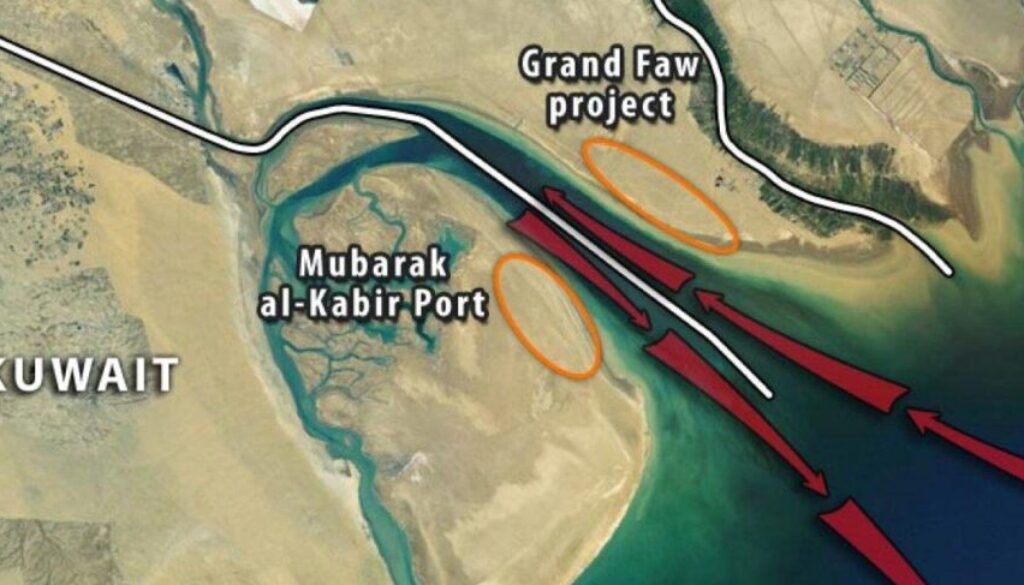BY DR SOHA MAAD
INTRODUCTION
The Mubarak Al-Kabeer Port is a significant infrastructure project located on Bubiyan Island in Kuwait. It is part of Kuwait’s Vision 2035 and China’s Belt and Road Initiative. The port aims to enhance regional trade and transportation, contributing to Kuwait’s economic diversification by reducing its reliance on oil.
The port’s development is divided into phases, with the first phase completed in 2021. The entire project is expected to be operational by 2026. Once completed, it will play a pivotal role in boosting Kuwait’s Gross Domestic Product GDP and fostering economic growth in the region. We present a complete overview of this major infrastructure project covering its various benefits, wider impact, and future prospect.
EXPECTED ECONOMIC BENEFITS AND STRATEGIC IMPORTANCE
The Mubarak Al-Kabeer Port is expected to bring significant economic benefits to Kuwait. The port will reduce Kuwait’s reliance on oil by boosting trade and commerce, aligning with the country’s Vision 2035. It aims to position Kuwait as a key transit point for regional trade, enhancing its role in global commerce. The development and operation of the port will open numerous job opportunities, supporting local employment.
The Mubarak Al-Kabeer Port holds immense strategic importance for Kuwait and the region. Positioned on Bubiyan Island, the port aims to connect Central and East Asia, becoming a key link in the revival of the Silk Road. The project enhances Kuwait’s transportation and logistics capabilities, strengthening its role in global commerce. It is expected to attract significant foreign investments while maximizing local economic growth.
CONNECTION TO BELT AND ROAD INITIATIVE
The Mubarak Al-Kabeer Port is closely tied to China’s Belt and Road Initiative (BRI), reflecting a strategic partnership between Kuwait and China. The port is a key component of the BRI, serving as a vital link in the Silk Road’s maritime route. It facilitates trade between East and West, enhancing connectivity. Kuwait and China have signed agreements to align the port’s development with the BRI, fostering mutual economic growth and investment opportunities. Positioned on Bubiyan Island, the port strengthens China’s trade network in the Gulf region, making it a critical hub for regional and international commerce. The project includes advanced facilities and logistics, supporting the broader goals of the BRI to improve global trade infrastructure.
KUWAIT’S VISION 2035 AND ITS REGIONAL TRADE DYNAMICS
Kuwait’s Vision 2035, also known as “New Kuwait,” is a strategic development plan aimed at transforming Kuwait into a global financial and trade hub. It focuses on economic diversification, reducing reliance on oil, and fostering a competitive private sector. The plan includes major infrastructure projects like the Mubarak Al-Kabeer Port, which enhances Kuwait’s regional trade dynamics. Kuwait’s membership in the Gulf Cooperation Council (GCC) facilitates regional trade through agreements and a unified customs union. Kuwait has signed multiple bilateral and regional trade agreements, boosting its economic ties with countries like China, the European Union (EU), and the United States (US). The focus on non-oil sectors and infrastructure development strengthens Kuwait’s role in regional commerce.
BENEFITS TO INDUSTRIES
The Mubarak Al-Kabeer Port is set to significantly benefit various industries in Kuwait. The port’s advanced facilities will streamline cargo handling and improve supply chain efficiency, boosting the logistics sector. By becoming a regional trade hub, the port will enhance import and export activities, benefiting businesses across multiple sectors. The development of industrial zones around the port will support manufacturing and light industries, fostering economic growth. The integration of power plants and substations will support energy-intensive industries and infrastructure projects.
NEW JOBS FROM MUBARAK AL-KABEER PORT DEVELOPMENT
The development of the Mubarak Al-Kabeer Port is expected to open a wide range of job opportunities across various sectors:
- Construction and Engineering: Jobs in infrastructure development, including civil engineering, project management, and skilled labor for construction.
- Logistics and Transportation: Roles in cargo handling, shipping, warehousing, and supply chain management.
- Port Operations: Positions such as dock workers, crane operators, and administrative staff for port management.
- Industrial and Manufacturing: Employment in light industries and manufacturing zones planned around the port.
- Tourism and Hospitality: Opportunities in tourism-related services as Bubiyan Island develops into a tourist destination.
- Environmental Management: Roles focused on ensuring the port’s operations align with sustainability goals.
REGIONAL IMPORTANCE
The Mubarak Al-Kabeer Port stands out among regional ports due to its strategic location, advanced infrastructure, and ambitious goals. Mubarak Al-Kabeer Port boasts the deepest berths among Kuwait’s ports, surpassing Shuwaikh, Doha, and Shuiba. It is designed to handle larger vessels and higher cargo volumes, making it a key player in regional trade. Unlike many other ports, it is closely tied to China’s Belt and Road Initiative, enhancing its role in international trade networks. The port’s planned expansion to include industrial zones, free trade areas, and enhanced connectivity through the Gulf Railway project sets it apart as a comprehensive trade and logistics hub. Its proximity to Iraq’s Grand Faw Port and Iran’s ports fosters a competitive dynamic, influencing regional trade strategies.
BENEFITS TO VARIOUS COUNTRIES
Mubarak Al-Kabeer Port will bring benefits to various countries including:
- Kuwait: As the host country, Kuwait benefits directly from the port’s economic and strategic advantages, aligning with its Vision 2035.
- Iraq: The port’s proximity to Iraq’s Grand Faw Port has sparked competition, influencing Iraq’s trade and infrastructure strategies.
- Iran: The port enhances regional trade routes, potentially affecting Iran’s maritime commerce.
- China: As part of the Belt and Road Initiative, the port strengthens China’s trade network and its influence in the region.
- Central Asian Countries: The port’s location makes it a key gateway for trade with Central Asia, boosting connectivity and commerce.
MUBARAK AL-KABEER PORT INFRASTRUCTURE
The Mubarak Al-Kabeer Port is a major infrastructure project located on Bubiyan Island, Kuwait. The port’s construction is divided into multiple phases. The first phase, completed in 2021, included the development of four berths. The entire project is expected to be operational by 2026. The port features state-of-the-art facilities for cargo handling, logistics, and transportation, making it a critical hub for regional and international trade. Bubiyan Island, where the port is located, includes power plants and substations to support the port’s operations. A 5,000-megawatt power plant has already been constructed in Subiya. The port is designed to be environmentally sustainable, aligning with modern infrastructure standards. The port is part of the Gulf Railway project, which aims to connect all six Gulf Cooperation Council (GCC) member states, enhancing regional connectivity.
FINANCE OF MUBARAK AL-KABEER PORT
The Mubarak Al-Kabeer Port is financed through a collaboration between Kuwait and China. The Kuwaiti government has allocated financial resources for the port’s development, emphasizing its strategic importance for the country’s economic diversification. China State Construction and Communications Corporation Limited (CSCC) is a key partner, providing expertise, design, and pre-implementation services. This partnership is supported by agreements between the governments of Kuwait and China. This collaboration highlights the mutual benefits for both nations, with Kuwait gaining advanced infrastructure and China expanding its trade network.
IMPACT ON REGIONAL GEOPOLITICS
The Mubarak Al-Kabeer Port has significant implications for regional geopolitics. Situated on Bubiyan Island, the port strengthens Kuwait’s position as a key player in the Gulf region, enhancing its influence in regional trade and transportation. By becoming a major trade hub, the port increases Kuwait’s economic leverage in the region, fostering stronger ties with neighboring countries and global partners. The port’s development aligns with Kuwait’s efforts to promote stability and cooperation within the Gulf Cooperation Council (GCC) and beyond. The port’s integration into this initiative highlights its global significance, connecting Kuwait to broader international trade networks.
FUTURE HORIZON OF MUBARAK AL-KABEER PORT
The future of the Mubarak Al-Kabeer Port is promising, with plans to significantly expand its capacity and influence. The port’s area is set to increase tenfold, reaching approximately 116 million square meters. This includes zones for maritime navigation, port services, free trade, light industries, and regional road and railway connections. The port is expected to be fully operational by the end of 2026, marking a major milestone in Kuwait’s Vision 2035. The expansion aims to attract local and foreign investments, diversify Kuwait’s economy, and create thousands of job opportunities.
The port is poised to become a cornerstone of regional trade, enhancing Kuwait’s role in global commerce.



